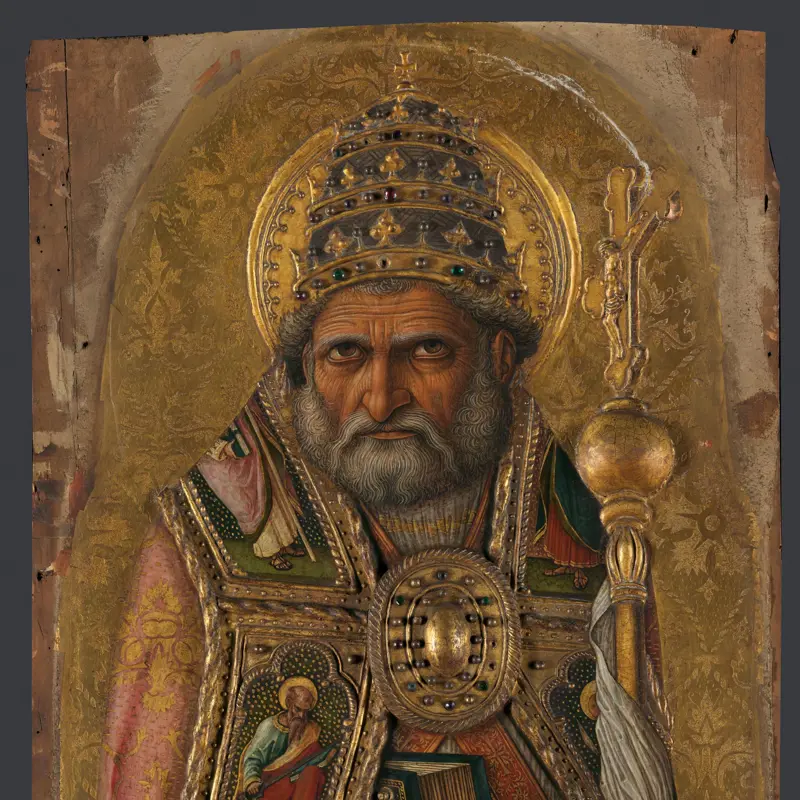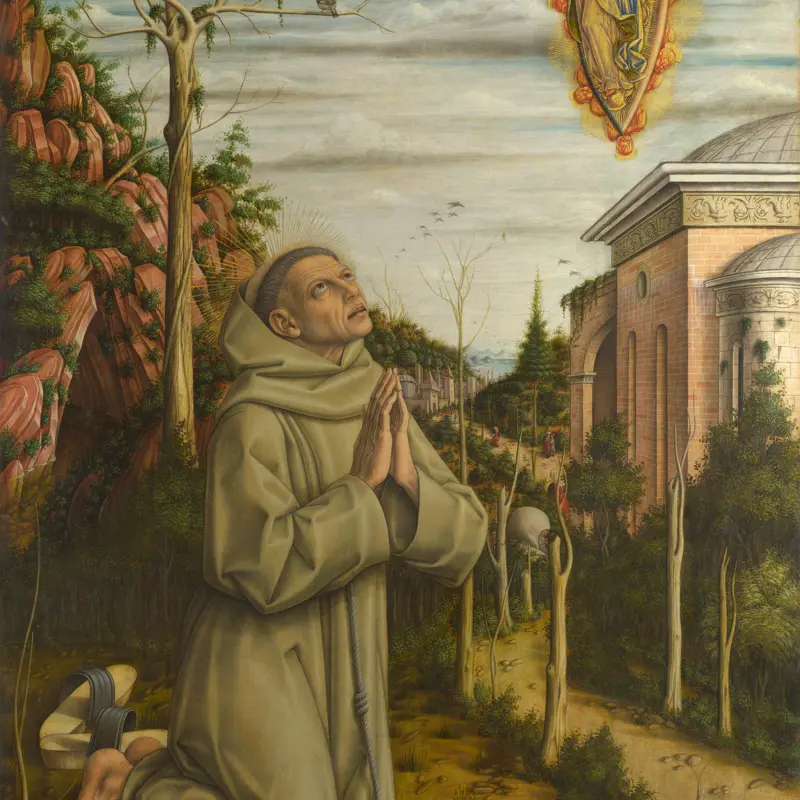Carlo Crivelli, 'The Demidoff Altarpiece', 1476
About the group
Overview
Crivelli painted two altarpieces for the small church of San Domenico, in the town of Ascoli Piceno in the Italian Marche. Their history is complex and intertwined. A large, double-tiered polyptych (a multi-panelled altarpiece) sat on the high altar, while a smaller altarpiece was in a side chapel.
In the nineteenth century parts of both altarpieces were sold to a Russian prince, Anatole Demidoff, who mounted them in a grand frame to make a three-tiered altarpiece for the chapel of his villa in Florence. The whole complex is now known as the Demidoff Altarpiece.
The National Gallery bought the Demidoff Altarpiece in 1868, and in 1961 the panels from the smaller polyptych were removed. They are now displayed separately.
Key facts
Details
- Full title
- The Demidoff Altarpiece
- Artist
- Carlo Crivelli
- Artist dates
- About 1430/5 - about 1494
- Date made
- 1476
- Inventory number
- NG788
- Collection
- Main Collection
About this record
If you know more about this work or have spotted an error, please contact us. Please note that exhibition histories are listed from 2009 onwards. Bibliographies may not be complete; more comprehensive information is available in the National Gallery Library.
Works in the group
-
The Virgin, crowned and richly dressed as Queen of Heaven, sits on a marble throne. She comes from a polyptych (a multi-panelled altarpiece) which Crivelli painted in 1476 for the high altar of the church of San Domenico, in Ascoli Piceno in the Italian Marche. A pink watered silk – a cloth of ho...
-
This striking half-naked figure is Saint John the Baptist. He comes from a large polyptych (multi-panelled altarpiece) which Crivelli painted in 1476 for the high altar of the church of San Domenico, in Ascoli Piceno in the Italian Marche. Crivelli’s attention to detail is such that we can see t...
-
This stern and commanding figure is Saint Peter, the first pope and one of the founders of the Catholic Church. He comes from a polyptych (a multi-panelled altarpiece) which Crivelli painted for the high altar of the church of San Domenico, in Ascoli Piceno in the Italian Marche. His hooded eyes...
-
This graceful, golden-haired princess is Saint Catherine of Alexandria, identifiable by her traditional attributes of a spiked wheel and martyr’s palm. She comes from the great polyptych (multi-panelled altarpiece) which Crivelli painted for the church of the Dominican Order in Ascoli Piceno in t...
-
This saintly friar comes from a large polyptych (a many-panelled altarpiece) which Crivelli painted in 1476 for the high altar of church of San Domenico at Ascoli Piceno in the Italian Marche. This is Saint Dominic himself, holding a white lily to symbolise his chastity and the book of his Rule –...
-
This praying saint comes from the upper tier of a large polyptych (multi-panelled altarpiece) which Crivelli painted in 1476 for the high altar of the church of San Domenico, in Ascoli Piceno in the Italian Marche. This is Saint Francis, founder of the Franciscan Order – friars who lived in towns...
-
This bearded saint is one of four in the upper tier of a polyptych (a multi-panelled altarpiece) which Crivelli painted in 1476 for the high altar of the Dominican Church in Ascoli Piceno in the Italian Marche. He is Saint Andrew, the first Apostle, and a particular favourite of the Dominican Ord...
-
This half-length figure of a saint comes from a large polyptych (multi-panelled altarpiece) which Crivelli painted in 1476 for the high altar of the church of San Domenico, in Ascoli Piceno in the Italian Marche. This is Saint Stephen, Christianity’s first martyr.Potato-like rocks – representing...
-
This half-length figure of a saint comes from the upper tier of a polyptych (multi-panelled altarpiece) which Crivelli painted in 1476 for the high altar of the church of San Domenico, in Ascoli Piceno in the Italian Marche. He is the theologian and Dominican friar Saint Thomas Aquinas (d. 1274)....
























